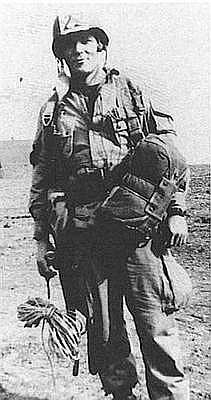Camp Toccoa
| Camp Toccoa | |
|---|---|
| Stephens County, near Toccoa, Georgia, U.S. | |
 | |
| Coordinates | 34°33′01″N 83°23′50″W / 34.5504°N 83.3973°WCoordinates: 34°33′01″N 83°23′50″W / 34.5504°N 83.3973°W |
| Type | Military training base |
| Site information | |
| Controlled by | United States of America |
| Site history | |
| Built | 1940 |
| In use | 1941 – ca. 1946 |
Camp Toccoa (formerly Camp Toombs) was a United States Army paratrooper training camp during World War II five miles (eight kilometers) west of Toccoa, Georgia. It was first planned in 1938, constructed by the Georgia National Guard and the Works Projects Administration beginning 17 January 1940, and was dedicated 14 December 1940. The U.S. Army took over the site in 1942.[citation needed]
World War II[]

The U.S. Army took over a site with few buildings or permanent structures: personnel were originally housed in tents. More permanent barracks were built as the first soldiers started to arrive.
Initially, Camp Toccoa used the Toccoa municipal airport for jump training, but following a transport accident, it was abandoned for having too short a runway for safe C-39 and C-47 operations. All further jump training occurred at Fort Benning, Georgia.
Camp Toccoa also lacked a rifle range, so airborne trainees would march 30 miles (48 km) to Clemson Agricultural College, a military school in South Carolina, to practice on the college's shooting range.
The most prominent local landmark is Currahee Mountain. Paratroopers in training ran from the camp up the mountain and back, memorialized in the HBO series, Band of Brothers, with the shout "three miles up, three miles down." Members of the 506th Parachute Infantry Regiment still refer to themselves as "Currahees", derived from the Cherokee word gurahiyi, which may mean "standing alone".[1] The regiment's crest is surmounted by a group of 6 fully deployed parachutes.[2]

Comedian Bob Hope visited Camp Toccoa and entertained the troops there in 1943.[3] He told the troops, "You guys are so rugged, you look like Wheaties with legs."[4]
After World War II[]
The camp closed at the end of the war. In the late 1940s, it served as a Georgia State Prison site, housing primarily youth offenders, but several escapes forced the state to close the site,[citation needed] moving the operation to a new facility at Alto, Georgia. The twisting trail up Currahee is now named for Colonel Sink. The only remaining building from the camp is the mess hall. The occupies a portion of the grounds.
In 2012 an organization, Camp Toccoa at Currahee, a not-for profit foundation, was formed to celebrate the lives and contributions of the Airborne paratroopers who trained at Camp Toccoa at Currahee Mountain during World War II. A plan was set forth to restore the facilities at the camp site.[5]
Units trained at Toccoa[]
This section does not cite any sources. (November 2011) |
- 501st Parachute Infantry Regiment: attached to the 101st Airborne Division
- 506th Parachute Infantry Regiment: attached to the 101st Airborne Division
- 507th Parachute Infantry Regiment: attached to the 82nd Airborne Division and the 17th Airborne Division
- 511th Parachute Infantry Regiment: attached to the 11th Airborne Division
- 517th Parachute Infantry Regiment: attached to the 17th Airborne Division and the 13th Airborne Division
- : attached to the 11th Airborne Division
- : completed basic training at Camp Toccoa, from July 21, 1943 through November 24, 1943.
- : completed basic training at Camp Toccoa, from July 21, 1943 through November 24, 1943
Name change[]
The facility was initially named Camp Toombs after Confederate Civil War General Robert Toombs. In 1942, Colonel Robert Sink, commander of the 506th Parachute Infantry Regiment, one of the first units to train there, thought that it would prompt superstitions to have young men arrive at Toccoa, travel Route 13 past the Toccoa Casket Company to learn to jump at Camp "Tombs", so he persuaded the Department of the Army to change the name to Camp Toccoa.[6]
References[]
- ^ Curraheee Mountain in Georgia Place-Names by Kenneth K. Krakow
- ^ "506th Infantry Website :: History". www.506infantry.org. Retrieved 2019-01-17.
- ^ "The Thunderbolt" (PDF). 517PRCT. Retrieved 30 January 2020.
- ^ Estep, Tyler. "Camp Toccoa reborn: Reviving one of Georgia's greatest WWII legacies". AJC.com. Atlanta Journal-Constitution. Retrieved 30 January 2020.
- ^ Clark, Heather (3 July 2013). "Camp Toccoa to live on: Historical society to preserve 506th birthplace". Army.mil. United States Army. Retrieved 5 July 2016.
- ^ http://www.rootsweb.ancestry.com/~gasteph2/histinfocmprbttmb.html
External links[]
- Closed installations of the United States Army
- Landmarks in Georgia (U.S. state)
- Buildings and structures in Stephens County, Georgia
- Forts in Georgia (U.S. state)
- 1940 establishments in Georgia (U.S. state)
- 1946 disestablishments in Georgia (U.S. state)
